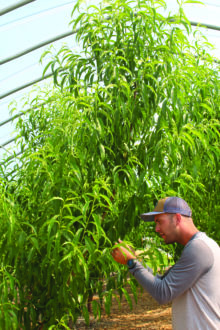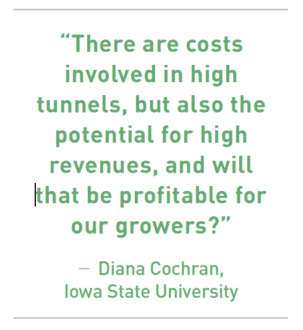

Dec 27, 2018Peaches, nectarines may thrive in Midwest chill


The cold winters in the northern Great Plains make growing peaches or nectarines a gamble.
“Iowa is cold. Growers only get a marketable crop one in four years – even if it’s in southern Iowa,” said Diana Cochran, Iowa State University (ISU) associate professor in the Department of Horticulture.
Peach trees are especially short-lived in Iowa – even under the best growing conditions.
“Growers plant peach trees knowing they will replace some every year,” Cochran said. “They still plant them because they get a premium price when they do get a crop of fresh peaches.”
However, new ISU research is looking at the possibility of growing peaches and nectarines in high tunnels as a way to make the crops more profitable. “A lot of work has been done on high tunnels elsewhere, but we are so much colder in the Midwest we wanted to see if it would work here,” Cochran said.
Researchers are evaluating the peach varieties, Redhaven and Contender, and the nectarine varieties Redgold and Fantasia to see how well they establish in high tunnels compared to the varieties grown in the field.
All of the plantings are on Bailey rootstocks. “Bailey originated from Iowa. It’s winter hardy and well-adapted to the area,” Cochran said.
First-year results showed significantly better growth and establishment for the peaches and nectarines grown in high tunnels.
The peach varieties Redhaven and Contender had about a 15 percent greater growth in the trunk area and nearly a 50 percent greater tree volume in high tunnels than the peaches grown in the field.
The nectarine Redgold didn’t have statistically significant greater growth in trunk area in a high tunnel but did have two-thirds more tree volume than when grown in the field. Fantasia had about a 25 percent greater growth in the trunk area and nearly double the amount of tree volume in a high tunnel.


Trees in the field grew to about 10 to 12 feet tall while trees in the high tunnels were up to 18 feet tall. That height may make hand-picking more difficult. “Most growers only have a few peach or nectarine trees so we’re not talking about a lot of time on ladders,” Cochran said.
Light quality differences in the tunnels compared to the field is emerging as a key issue in the study.
“Is the light quality the same?” Cochran asked. “It appears to be the significant growth factor.”
An evaluation of dwarfing rootstocks on the peaches in the high tunnels will soon be added to the study.
“There has been a lot of research in tunnels elsewhere,” Cochran said. “We thought let’s try it in Iowa. There are costs involved in high tunnels, but also the potential for high revenues, and will that be profitable for our growers?”
– Dean Peterson, FGN Correspondent














